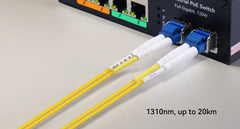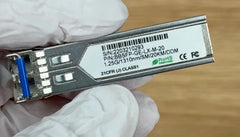What's is SFP? What is used for? What's the benefit of SFP to industrial applications?
Have you ever noticed that intriguing port on your PoE switch and the distinct cable connector that accompanies it? If not, you're about to discover its significance, especially in the realm of big scale networks and businesses requiring extensive network coverage.

Now, let's tackle the burning questions:
Q: What is the SFP, and what does it mean?A: The SFP port stands for Small Form-factor Pluggable port. It's a compact slot designed for SFP transceivers, allowing the insertion of hot-swappable modules. These modules facilitate the connection of fiber optic or copper Ethernet cables to the switch, commonly used for uplink connections in networks.
Q: What is it used for?A: The SFP port on a PoE switch serves multiple purposes. It's the go-to solution for high-speed data transfer, ranging from 10 gigabit (SFP+) to a staggering 400 gigabit (QSFP 56DD). This port excels in low latency, as evidenced by a meticulously crafted latency chart in microseconds. Moreover, it's the gateway to long-distance data connectivity, with some types, like Type ZX, boasting a maximum reach of up to 80km. Primarily, SFP ports facilitate uplink connections to other switches, routers, or network devices using fiber optic or copper Ethernet cables.

In industrial settings, the benefits of SFP ports in PoE switches are manifold:
- Flexibility in Connectivity: SFP ports offer a spectrum of connectivity options, accommodating both fiber optics and Ethernet cables. This versatility ensures seamless connections for different devices and diverse network setups.
- Enhanced Distance Reach with Fiber Optics: The integration of fiber optics extends the reach of industrial networks. Overcoming the limitations of standard Ethernet cabling, SFP ports enable longer transmission distances without signal degradation.
- Scalability and Easy Expansion: PoE switches equipped with SFP ports pave the way for scalable industrial networks. As your network grows, additional devices can be effortlessly integrated without the need for substantial infrastructure changes, providing a cost-effective and scalable solution.
- High-Speed Data Transfer: Crucial for applications requiring swift and reliable data transmission, SFP ports support high-speed data transfer. This capability is particularly vital in industrial settings where real-time data communication is an absolute necessity.